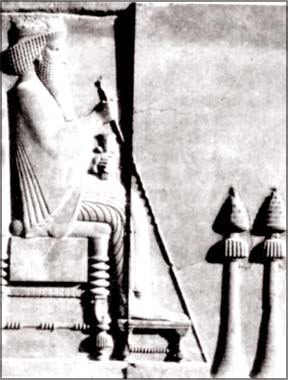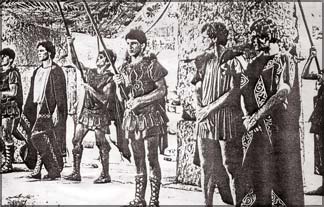Kingdoms of ancient and medieval India
Kamalika PIERIS
In the ancient and medieval period, the Indian peninsula held many
separate kingdoms. Some kingdoms were small, such as the Chutus of
Maharashtra and the Ikshvakus of the Krishna-Guntur region of Andhra.
Other kingdoms were extensive. The huge Satavahana Empire, ruled by the
Satavahana dynasty from the 3rd century BC to 3rd century AD, covered
the whole of the Deccan and extended from coast to coast. Harsha of
Kanauj (606 - 647 AD) ruled over a large northern kingdom, which
included Punjab, Nepal and Kashmir. Some kingdoms were stable. Orissa
and Kerala became separate kingdoms with settled boundaries in the 7th
century. Some dynasties were long lived.
|

King Darius I seated before two incense burners. He was one
of the greatest rulers of the Achaemerid dynasty. ANCL file
photo. |
The Palas ruled in Bengal and Bihar from 760-1142 AD. Ancient India
saw the rise of two empires but neither included the whole of present
day India. Maurya kings (321 BC- 185BC) ruled over the Indus and Ganges
plains and south India up to Mysore. Gupta kings (320- 454 AD) ruled
over parts of north, east and western India. They received tributes from
north-west and central India, as well as Andhra and Tamil kingdoms. Both
empires disintegrated into independent states. Anarchy often prevailed
in the period between Maurya and Gupta rule in north India.
North India was repeatedly invaded and ruled by West Asian and
Central Asians They came through the north western passes which the
Indian kings left unguarded, in the hands of local rulers. The invaders
were superb horsemen and the Indian cavalry could not stand up to them.
Alexander the Great arrived in India from Macedon in 327-326 BC. He
occupied Kabul and the Indus valley.
Persian King Darius I (522-486) conquered parts of Afghanistan,
Pakistan and India down to Rajputana. From Central Asia came the Pathans,
Bactrians, Huns, Kushans and Shakas. Kushan king, Kanishka (78-101AD)
controlled all the western half of north India, from Gandhara to
Ayodhaya, including Benares and Sanchi. The Shakas ruled over Cutch,
Kathiawar and Malwa up to the 5 century AD. The Rajputs held power in
north western India in the 9th and 10th century. They ruled in Malwar,
Kathiawar, Mewar, Gwalior and Udaipur. They were of foreign origin and
operated in clans.
Turks from Afghanistan invaded in the 11th century. They fought
efficiently and were superior horsemen. They took Lahore in 1185 and set
up the Delhi Sultanate in 1206. They conquered Bengal and Bihar. In the
Deccan, the breakaway Bahamani kingdom declared independence from Delhi
in 1347 and ran the northern Deccan for two centuries. Daulatabad was
one of its centers. This kingdom was eventually absorbed into the Moghul
Empire.
From 12 century onwards, India came under Muslim rule. Between 1206
and 1526 five successive dynasties of Turks and Afghans ruled from
Delhi. Afghans, Arabs, Mongols, Turks, and Persians poured into north
India. The green, brown and blue eyes of present day north Indians are
due to this ethnic mix. Turks and Afghans settled in the towns. They
held elite status. The Rajput chiefs and other local rulers also came to
be accepted as nobility, when the Sultanate found that it had to come to
terms with them after many inconclusive wars. The villages and rural
areas had considerable local autonomy.
The Mongols were Central Asian Turks from east of the Caspian Sea in
what is now southern Russia. Mughal is the Persian variant of Mongol.
The ‘Mughal’ dynasty in India started with Babur (1483-1531). Babur was
related to both Timur and Genghis Khan. Babur was succeeded by his son
Humayun, then Akbar (1556-1605) Jehangir, Shah Jahan, Aurangzeb
(1657-1707) and Bahadur Shah.
|

In a dazzling ceremony 20-year-old Alexander (Nicholas Clay)
is crowned King of the Greeks. He is flanked by his trusted
friend Hephaistion (Ian Charleson, second from right).
ANCL file photo. |
The Mughals used Persian as the official language and as a literary
influence. Persian was the official language of Muslim India. Persian
names became popular. . Persian architectural elements were introduced,
notably the pointed arch, the dome and octagonal shape. Today’s much
admired Indian architecture, such as Taj Mahal, is largely Persian (Iranian).The
Muslim nobility also introduced innovations to north Indian classical
music and dance.
In the meantime, there arose in the south, the Vijayanagara Empire
(1366- 1646). Within four decades it controlled the whole of south
India, including Kerala, Tamilnadu, Karnataka and Andhra Pradesh. It was
ruled from Vijayangara, near present day Hampi in Karnataka. Under
Devaraya (1422-46) it became the most powerful state of the time in
India.
The most prominent element in Indian politics was not good
governance. It was war. Harsha of Kanauj maintained a large army and was
surrounded by smaller kings always ready to go to war. Vijayangara was
constantly faced with invasion from the adjoining Bahamani kingdom and
the king maintained a large standing army. Much of the revenue of the
Pallavas and Chalukyas went to maintain the army.
Sastri says that the wars in south India were fought with unusual
bitterness and were marked by much wanton destruction, cruelty and
‘sickening horrors.’ The motive was invariably territory. In south
India, the kings wanted to control the entire waterway of the Godavari
and Krishna rivers which started in the west and entered the sea in the
east.
South India fought over this for centuries, across the rise and fall
of several dynasties. Vengi in modern Andhra Pradesh was frequently the
bone of contention, since it lay between these two rivers.
Chalukyas of Badami, the Pallavas of Kanchipuram, and the Pandyas of
Madurai fought each other throughout a period of 300 years from the
middle of 6th century to 9th century AD, seeking constantly to grab each
others territory . Rashtrakutas (757-973 AD) who ruled from Karnataka
were always fighting. They had Amoghavarsha as king for 66 years. The
whole period was full of wars. In the 11th and 12th centuries there was
continuous war between the Cholas and neighboring Western Chalukyas.
Chola king Kulottunga I and Chalukya king Vickramaditya VI fought for
about half a century. The rulers also fought among themselves. The
Rajput clans fought each other unceasingly. They were always trying to
seize each others territory. When they were not fighting the Sultanate,
they were fighting each other. The Bahamani rulers quarreled a lot among
themselves.
(The writings of A.L. Basham, C.R.Boxer, S. Kiribamune, R.C.
Majumdar, K. A. Nilakanta Sastri, K.M. Panikkar and R. Thapar were used
for this essay). |



